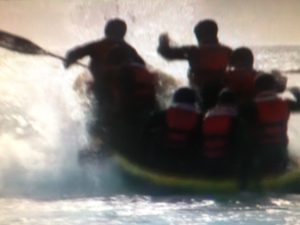
Becoming a Navy SEAL BUDS Training means surviving one of the most challenging training programs. This journey starts with an intense selection process designed to push candidates to their mental and physical limits. It’s not just about brute strength; it’s a comprehensive test of endurance where even Hell Week’s daunting 75% dropout rate doesn’t tell the whole story.
Dive into what makes these warriors elite as we break down each phase from grueling essential conditioning to advanced combat diving and land warfare tactics. You’ll see how SEALs are built for resilience through every punishing week beyond eight months before they even hit specialized post-graduation training like sniper school or free-fall parachuting.
And at the core? Mental toughness is non-negotiable. Let’s explore why psychological fortitude isn’t just part of the program—it’s essential for survival in some of the most high-stress situations imaginable.
Navy SEAL BUDS Training Table of Contents:
- The Grueling Selection Process of Navy SEALs Candidates
- Phase One: Basic Conditioning
- Phase Two: Combat Diving
- Phase Three: Land Warfare Training
- Advanced Specialized Training Post-Graduation
- The Importance of Mental Toughness in SEALs Training
- FAQs to Navy Seals Training
- Conclusion
The Grueling Selection Process of Navy SEAL BUDS Training
Imagine trying to climb Mount Everest, but instead of a mountain, it’s endless physical challenges and sleepless nights. That’s the start line for aspiring Navy SEALs. In this gauntlet known as Hell Week, candidates face relentless tasks designed to push them beyond their limits.
Hell Week: The Ultimate Test of Endurance
Candidates endure five-and-a-half days with less than four hours of sleep. They’re running on empty while tackling obstacle courses that would make most people’s muscles scream in surrender. The attrition rates are telling, soaring over 75%, which speaks volumes about the sheer toughness required to keep standing.
The ocean becomes both ally and adversary as trainees spend hours wading through frigid waters or paddling rubber boats against punishing waves—all under watchful eyes, looking for any sign of falter.
Through bone-chilling cold and skin-scraping sand, these men forge an unbreakable will; they either emerge solidified by the ordeal or realize this path isn’t theirs to walk—a sobering reality check served up courtesy of Mother Nature herself.
Phase One: Basic Conditioning
The road to earning the coveted Navy SEAL trident starts with Phase One, a grueling 8-week gauntlet not for the faint of heart. Think punishing runs, ocean swims that’ll chill you to the bone, and calisthenics designed to push your body past its limits.
Physical Training Regimen
Dawn breaks, and so does the resolve of many as candidates hit the ground running. Each day starts with a run along sandy shores or through obstacle-laden courses. And just when you think it can’t get more intense, welcome to muscle-burning calisthenics sessions where “just one more” feels like an impossible dream.
Think again if you’re picturing leisurely laps in a pool during swim time. The waters are open and often unforgiving; they test your willpower as much as your stroke technique. Don’t forget hell week, which is 5 1/2 days of about four hours of sleep of pure misery and cold water. The majority of the dropouts occur during this real-life nightmare.
Water Competency Tests
To conquer these tests is no small feat; SEAL hopefuls must master underwater problem-solving while their lungs scream for air—a testament to mental grit and physical prowess. Mastery here isn’t just about speed but grace under pressure—the composure that separates potential SEALs from those who merely tread water.
Phase Two: Combat Diving
Imagine sneaking up on the enemy undetected from beneath the waves. That’s where combat diving comes into play for Navy SEALs candidates in their second training phase. Over roughly eight weeks, they’re thrown into a world where SCUBA and closed-circuit diving become second nature.
Closed-Circuit Diving Operations
This isn’t your vacation snorkel trip; it’s serious business with life-or-death stakes. Closed-circuit diving allows SEALs to dive without leaving a trail of bubbles—crucial for stealth operations. It takes more than just holding your breath; these guys learn advanced underwater navigation skills that would make even Poseidon nod in approval.
Breathing apparatuses don’t have user manuals written in plain English, so SEAL candidates must get technical—and fast. They must master complex equipment that recycles air and scrubs out telltale bubbles, which could give away their position faster than a flare gun at night.
In this high-stakes game of hide-and-seek, becoming proficient means drills upon drills until every move is muscle memory because when you’re deep under the ocean surface behind enemy lines, there’s no room for error or do-overs.
Phase Three: Land Warfare Training
By the time candidates hit Phase Three, they’ve got a solid grip on basic conditioning and combat diving. Now, it’s about to get real with land warfare training that lasts roughly nine weeks. This is where SEAL hopefuls sharpen their teeth in weapons, tactics, and survival skills for when things go sideways.
Demolitions and Firearm Proficiency
The boom of explosives isn’t just noise; it’s music in this stage of SEAL prep. Candidates learn the ins and outs of demolitions—because sometimes you need to blow a door rather than knock. They also dial in their marksmanship because hitting your target is necessary when the pressure’s on.
This part isn’t just pulling triggers and lighting fuses; it’s about mastering tools that can turn the tide during critical moments on any mission.
Patrolling and Small Unit Tactics
Guerilla warfare techniques take center stage as teams creep through hostile territory—it’s like hide-and-seek but with higher stakes. Reconnaissance missions are also critical here; seeing without being seen can save lives or secure victories.
Advanced Specialized Training Post-Graduation
Becoming a Navy SEAL doesn’t stop after Hell Week or even after the final phase of basic training. These warriors take on an extra 18 months of specialized training that’s as intense as essential. It’s where they transform from tough to virtually unstoppable.
Sniper School: Precision Under Pressure
The art of being unseen and making the shot count every time—that’s what sniper school is all about. Candidates learn more than just pulling a trigger; they become experts in ballistics, camouflage, and long-range marksmanship. Think chess, but with higher stakes.
This advanced course isn’t for everyone, though—it demands extreme focus and patience.
High Altitude Low Opening (HALO) Free-Fall Parachuting
Dropping into hot zones from altitudes so high oxygen masks are needed? That’s just another Tuesday when you’re HALO trained. This program pushes SEALs to master precision free-fall techniques that let them arrive undetected anywhere in the world—because sometimes you need to make an entrance without knocking on the front door.
Sure enough, these courses aren’t your average postgrad programs—they’re life-saving skills forged under fire and pressure.
The Importance of Mental Toughness in SEALs Training
Mental toughness isn’t just a buzzword for Navy SEALs; it’s the backbone of their training. As vital as physical strength, psychological resilience keeps these warriors sharp when fatigue hits like a freight train, and stress cranks up to eleven. So yeah, you bet mental conditioning takes center stage alongside those grueling push-ups.
Imagine powering through Hell Week—where candidates are pushed past human limits with barely any sleep or rest—and doing that with a smile. Okay, maybe not a smile, but grit. That’s because over 75% of those who start this crucible won’t see it through to the other side without an ironclad mind.
But let’s be honest: developing this fortitude doesn’t happen overnight. It’s woven into every part of SEAL training, so by graduation day, these operators are ready for whatever chaos comes their way—with cool heads and steady hands.
Navy SEAL BUDS Training Conclusion
So, you’ve journeyed through the intensity of Navy SEAL training. You’ve grasped that it’s more than muscle; it’s a test of will where only the toughest prevail.
You’ve seen how weeks of basic conditioning lay the groundwork. Then, combat diving and land warfare add layers to their lethal skillset.
It will help if you remember this: Hell Week breaks many, but for those who push through, there’s an 8-week crucible of water trials followed by another 8 in underwater tactics. And don’t forget about mastering land operations over nine grueling weeks.
Navy SEALs Training doesn’t stop at graduation either; advanced specialized courses await these warriors as they prepare for whatever lies ahead, with unyielding mental toughness woven throughout every phase.
To wrap up, Mental grit is vital—without it, even the strongest falter under such extreme pressure. It’s not just about surviving—thriving in some of Earth’s harshest conditions that mold a SEAL.
